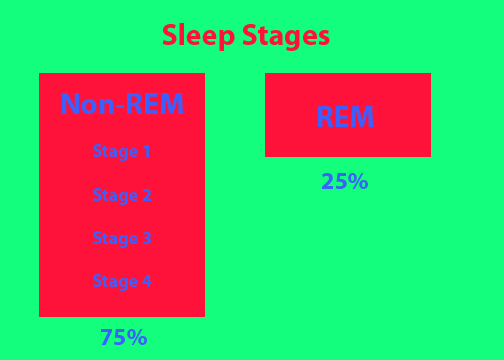Hey
everyone! I've recently completely renovated and expanded this site. In
fact, it's so much expanded that I wanted to start it fresh at a new
domain. You can check out the new home at
End-Your-Sleep-Deprivation.com
Warmly,
Kevin Morton
Sleep Step 2: The Two Types of Sleep
In other words, sleep is not just sleep!
The two main types of sleep:
Sleep can be divided into 2 main categories, REM (rapid eye movement) sleep, and non-REM sleep.
Additionally, non-REM sleep can be subdivided into 4 stages, distinguishable by levels of EEG and increasing in the deepness of sleep at each stage.
A typical night’s sleep consists of 75% non-REM sleep and 25% REM sleep. So a basic picture we get of sleep looks like this:

Beyond this simplified view there is much more that can be said on the two types of sleep.
REM Sleep
The most exciting stage of sleep, REM sleep is the stage where dreams occur. This connection between REM sleep and dreams was first made in 1953 by Eugene Aserinsky, Nathaniel Kleitman, and our own Dr. Dement.
The rapid eye movements for which REM sleep is named are a result of the brain trying to scan the events in the dream world. In other words, if one looks left and right during a dream, the sleeper’s actual eyes will follow the dream gaze and move left and right under his or her eyelids. This widely accepted theory is known as the scanning hypothesis.
In order to conjure a dream, the brain has to be highly active. In waking life the brain perceives and reacts to the world around a person. During dreaming the brain is not only perceiving and reacting, but also creating the environment. Thus, it makes sense that mental activity is very high during REM sleep.
Another characteristic of REM sleep is paralysis. If we were not paralyzed at this stage of sleep our entire body would be free to follow our eyes in acting out the dream and we would undoubtedly do some crazy things (not to mention things that would be very dangerous and/or not conducive to a good night’s sleep).
REM paralysis is achieved by the REM atonia system, which creates a blockage of final nerve pathways, essentially inhibiting directions to react given by the brain from reaching the muscles. However, not every muscle group is paralyzed. The diaphragm functions to let us breathe, smooth muscle groups such as the urinary sphincter work, as do the eye muscles, which has given researchers much to study in REM sleep.
The Stanford Sleep Book simplifies this information nicely when it says that in REM sleep, on has "a highly active brain in a paralyzed body.”
Non-REM Sleep
Unlike REM sleep, the sleeper is not fully paralyzed during non-REM sleep. In fact, non-REM is characterized by continuous low-level muscle movements in the neck and jaw muscles. The sleeper can also roll around and shift positions during non-REM, but movement is still very infrequent compared to wakefulness, as might be guessed.Throughout the night, your body progresses in and out of the stages of non-REM sleep, and each stage has its own very unique characteristics.
Stage 1
Stage 1 sleep is a transition period from wakefulness to the other 3 stages of non-REM sleep. It is of short duration, usually lasting only from 1 to 7 minutes. Stage 1 sleep is characterized by low voltage, mixed frequency EEG, as well as some slow, rolling eye movements and some relatively higher EMG activity.
Stage 2
Stage 2 makes up the bulk of an average person’s sleep each night, around 40 to 45 percent. A sleep researcher can easily recognize stage 2 sleep because of the presence of sleep spindles and K-complexes in the EEG waves. A sleep spindle is a rapid wax and wane of the EEG waves in a 1 to 2 second interval, while a K-complex is a large wax and wane of the wave that somewhat resembles a mountain.
Stage 3
Stage 3 and stage 4 are similar and both fall into the category of slow wave sleep. They are so named because of the high amplitude waves in the EEG. In order to qualify as stage 3 sleep, these slow waves must be present in no more than 50 percent of the epoch. The waves are also referred to as delta waves.
Stage 4
The other slow wave sleep period, in order to qualify as stage 4 sleep the high amplitude delta waves must be present in more than 50 percent of the epoch.










